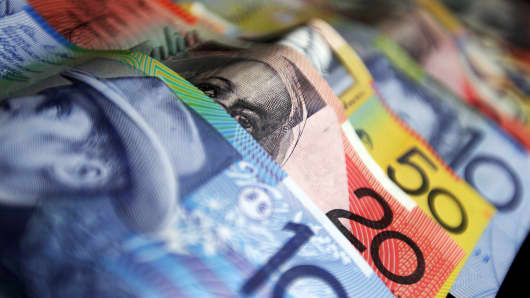In just under two weeks, this major currency has tumbled more than three percent. No, it's not the battered Japanese yen or beleaguered British pound, but the sturdy Australian dollar that's taking a beating.
Australia's currency fell to a six-week low of $1.0219 on Tuesday, dented by data showing a key gauge of manufacturing activity in China fell to a two-month low in April, fueling concerns about a slowdown in the world's second largest economy.
(Read More: China's PMI Miss: Is It Downhill From Here?)
In fact, the recent sell-off in commodities and signs of weakness in China, Australia's biggest export market, have soured sentiment towards the currency, which is expected to remain out of favor at least in the short-term, currency analysts say.
"Sentiment has turned towards the Aussie dollar and the currency has been a one-way bet over the past two weeks," said Mitul Kotecha, the head of global currency research at Credit Agricole in Hong Kong.
"I am looking for a test of the $1.02 level and if we break through there then we could test this year's low of $1.0116," he said, adding that weak domestic data and soft China data were taking a toll on the currency.
The Aussie dollar has fallen more than three percent from a three-month high set against the greenback on April 11 at around $1.0583. Compare that move with the Japanese yen, this year's worst performing major currency, which is down just 0.5 percent in the same time period.
(Read More: Poll: Will the Dollar Hit 100 Yen This Week?)
So What Now?
"The picture looks bearish for the Aussie dollar and we can expect more downside in the near term," said Kotecha.
Westpac Bank expects the Aussie dollar to test the $1.0150 in the weeks ahead, implying a further loss of roughly one percent from current levels.
(Read More: 'Rude Shock' Ahead for Commodity Currencies: Pro)
Currency analysts said Wednesday's Australian consumer price data for the first quarter could be the next key near-term driver of the currency since it could help shape market expectations for where interest rates are headed.
Australia's central bank left its key interest rate unchanged at 3 percent in April and many economists have scaled back expectations for monetary easing in the months ahead.
Analysts said that although the Aussie dollar was likely to stay under pressure in the short-term, the currency was likely to rebound in the second half of the year.
(Read More: Why the Aussie May Not Escape This Time)
"Understandably, the weak global data, especially the China data, is weighing on the Aussie dollar, but we expect it to continue trading within the $1.02 to $1.06 range that we've seen over the past nine months," said David Forrestor, G10 foreign exchange and fixed income strategist at Macquarie bank in Singapore.
"Both the Bank of Japan and the Fed [U.S. Federal Reserve] are printing money to the tune of about $160 billion on a monthly basis, so you have this freshly printed money looking for a home and the Aussie and Kiwi [New Zealand dollar] are still the highest yielders," he said.
—By CNBC.Com's Dhara Ranasinghe, Follow her on Twitter: @DharaCNBC



